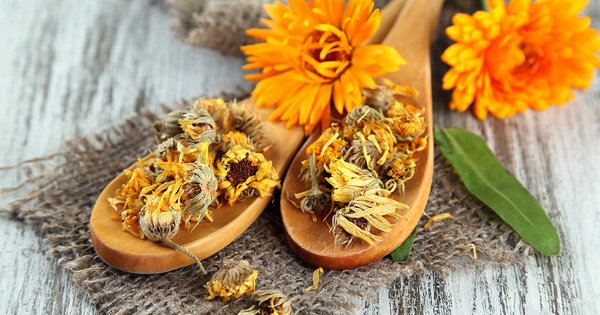That marigold on your windowsill can go in your salad, become a soup, soothe your sore throat or treat your eczema. Although a common garden plant, marigold (Calendula officinalis) has a long history as food and medicine. The Egyptians employed calendula as a rejuvenating herb, while the ancient Greeks utilized the golden petals to garnish and flavor food.
Long used in Europe as a culinary plant, the beautiful orange flower petals are a vibrant addition to a salad and are added to cheese and butter for color. Calendula is a delicious, velvet textured base for broth, soup or rice dishes. Children particularly like the taste, and it's well suited to their health needs. You can even have a sip of calendula wine.
Although not a strong herbal medicine, calendula is a multipurpose standout. It's anti-inflammatory, antispasmodic, antiviral, anti-fungal and anti-bacterial. It heals wounds, increases bile flow, and cleanses the lymph system. In Europe, calendula was known to comfort the heart, soothe agitation, strengthen eyesight and draw evil spirits. Calendula has a long history of use for headaches, jaundice, red eyes, and toothaches.
The most popular medicine use for calendula is in treating irritated membrane conditions. During the Civil War, doctors used calendula leaves were by to treat open wounds on the battlefield. Calendula flower is among the most soothing of herbs for salves. For soothing children's skin, herbalist Aviva Romm, author of Natural Healing for Babies and Children, uses it along with chickweed leaf, plantain leaf, comfrey leaf, and chamomile flower. One study of calendula for wounds showed that it noticeably stimulates physiological regeneration and skin healing.[i]
Calendula salve heals wounds, rashes and inflammatory skin lesions with itching, burning, and swelling. Rub the flower into sites of bee stings to reduce swelling and pain.[ii] Or make a compress for burns, scalds, sore nipples or stings by chopping the flowers and moistening with water.[iii] The sap from the fresh stem is used to eliminate calluses, warts, and corns.[iv]
For diaper rash, apply calendula cream with yarrow oil. To soften and moisturize tired feet, use lotions containing calendula flower with chickweed leaf, plantain leaf, comfrey leaf, and chamomile flower.
Calendula cosmetic creams will soften and smooth the skin, heal pimples and reduce large pores.[v] A preliminary study showed that, used twice a day, the herbal rinse with calendula reduced plaque by 50% and reduced gum pockets by 1-2 mm.[vi]
Internally, calendula helps heartburn (gastritis). A Bulgarian study of 137 patients found that a mixture of comfrey and calendula eliminated pain in 90% of the participants.[vii] The tea will treat internal hemorrhage, inflammation of the throat and nasal passages and menstrual cramps. Apply the tea externally as a wash for conjunctivitis and earache. A 2001 study found that a naturopathic herbal extract eardrop containing calendula treated earache as well as anesthetic eardrops.[viii] Suppositories help colitis and vaginal irritation. In one older study from Europe, twenty-four patients received an herbal mixture containing dandelion, Saint Johnswort, lemon balm, calendula and fennel. Ninety-five percent had total relief of colitis symptoms in 15 days.[ix]
Calendula is mildly anti-viral. Herbalists say that it seems to have an affinity for the lower half of the body, where it combines synergistically with echinacea. The mild diaphoretic action of calendula also helps shorten colds. For the lymph system, calendula targets the breast and pelvic tissues, where it stimulates the drainage of enlarged, inflamed lymph nodes. Naturopathic physicians use it as poultice to drain fibroid breast cysts.[x]
Calendula is a general remedy for liver disorders. It contains a resin, calendulin, which promotes bile flow, aiding digestion.
Who would have thought that such a pretty little plant could be such powerful medicine?
Diaper Rash Powder
All very finely powdered:Mix. Put in shaker.
- 2 parts calendula flower
- 2 parts slippery elm bark
- 1 part lavender flower
- 1 part dry clay
What to TakeReferences
- Tea - 2 tsp. per cup
- Wash - Brew 1 Tbs. in 1 cup of water
- Soup - 6-10 flowers in a pot of soup
- Tincture - up to 15 ml per day
- Salve - Apply to sores and rashes




Comment: For more information on the benefits and applications of medicinal herbs see: The Health & Wellness Show: Medicinal Herbs